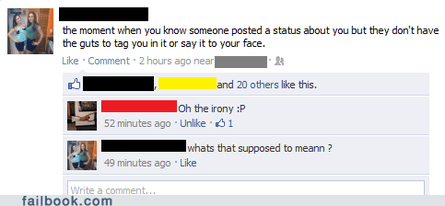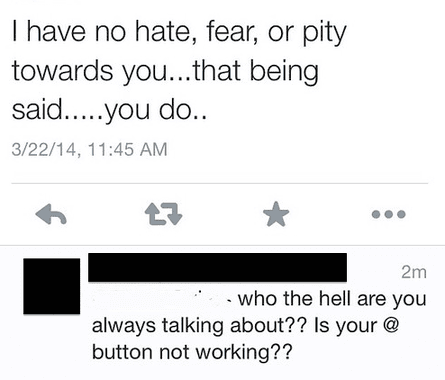Subtweeting: it’s the internet equivalent of talking about someone behind their back – or at least that’s how people usually explain it.
But in truth, the art of subtweeting consists of many different strokes. It’s not something that can be so succinctly defined. Subtweeting can be brilliant, it can be cruel, it can be rude, it can be annoying as hell.
Here’s a little guide on what subtweeting is, how it’s mostly employed, how to do it wrong, and how to do it well.
The basics
A subtweet means you are commenting about someone who you have not @ in. For those people who were born in 1880 who are new to Twitter, an @ symbol followed by a person’s Twitter username is known as a Twitter "mention".
This means that they will receive a notification whenever you include them in a tweet, and other people will be able to see the link to their Twitter account.
The person mentioned will keep receiving notifications related to the tweet in which they were mentioned. It’s at the core of how Twitter works, and how people use the service to communicate.
Variations of subtweeting – what’s in a name?
Some people include in the definition of subtweeting an instance when one mentions a person’s name but doesn’t @ mention a person’s name. (Guys, I didn’t say this was simple.)
For example, if I were to subtweet my boss, Jemima, some people would deem it subtweeting if I wrote: “Jemima Kiss eats too much salt”. If I wrote something like “My boss eats so much salt that she’s basically Lot’s wife”, that would be be considered a definite subtweet, if a genial one.
Here’s an example of when I subtweeted newsreader Susanna Reid by mentioning her name, but not her twitter handle. Which backfired when she saw it.
@ladyhaja !!
— Susanna Reid (@susannareid100) July 8, 2014
Subtweeting someone while identifying them by name usually happens if: in this case, you are talking about a public figure in a not-really-offensive tweet; making a general observation, but not needing to specifically address them; or if a celebrity has a twitter handle that bears no relation to their name and you want people to know who you are talking about. (Russell Brand, for instance, whose Twitter handle is @rustyrockets).
Some people don’t have Twitter – they still talk "face to face" (??) – so it may be necessary to name them in a Tweet if you want to say something like: “Susanna Reid and I in Malaga 2014 #yolo!”.
The final reason would be if you wrote a horrible tweet about someone with their name in it and you are basically a v mean/cowardly person indeed.
Variations of subtweeting – anon
A lot of people will only call something a subtweet if it explicitly does not identify anybody by name or mention, but the tweet is about and/or subliminally directed at someone.
In this sense, the subtweet is the Twitter-born cousin of vaguebooking. If you think you don’t know what vaguebooking is, you absolutely do:

Vaguebooking statuses often end in either ellipses or emoticons, though vaguebooking is slightly different to subtweeting, which always has to be about a person. Sometimes vaguebooking is just a means of general attention seeking.
It’s insulting someone via stealth. Instead of confronting someone in the playground, it’s passing a note about them in the classroom. This is why some parents are worried about subtweeting as a form of cyberbullying. Conversations can crop up as Twitter back-and-forths about a person, but without explicitly naming them.


The best subtweets, however, can be incredibly witty and waspish – think of an Oscar Wilde one-liner. These subtweets are the very best, in that the person being subtweeted knows it refers to them, but the tweet is also decipherable to a user’s general audience, and isn’t out-and-out obvious as a bitchy tweet about someone else. If it is obvious, then you’re falling into the trap of vaguebooking.
You want your tweet to be a generally strong tweet, which makes people laugh, or nod their head in recognition, while also being obvious to your target that it’s about them. You don’t want to come across as bitchy, bitter, sad, passive aggressive or attention-seeking (which, unfortunately most subtweets do). It’s a very specific skill.
WTF #subtweet
Some people have now taken to using a subtweet hashtag, which totally defeats the object. The people who tend to end their subtweets with “#subtweet” have usually subtweeted so clumsily that people already know it’s a subtweet (see pitfalls above). That’s just #stupid.
Why do some people use #subtweet hashtags on subtweets? Silly. #subtweet
— HannahJane Parkinson (@ladyhaja) July 22, 2014

Comments (…)
Sign in or create your Guardian account to join the discussion